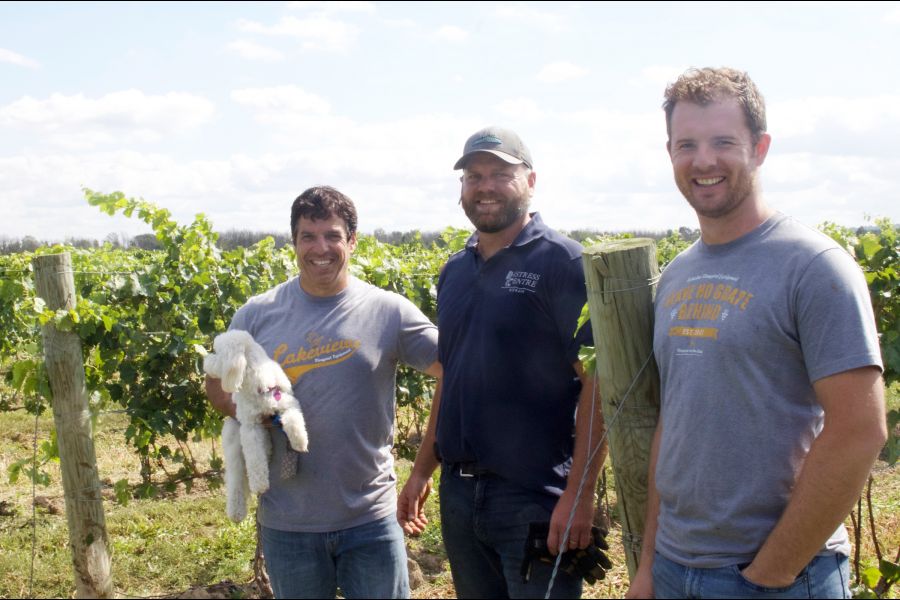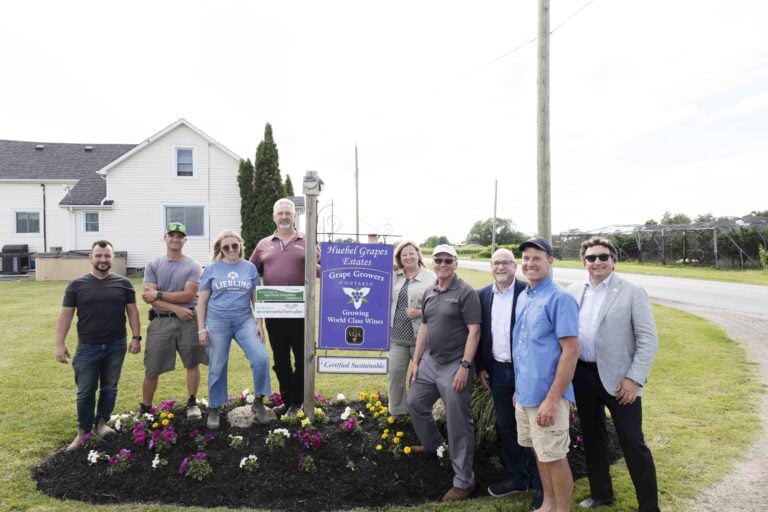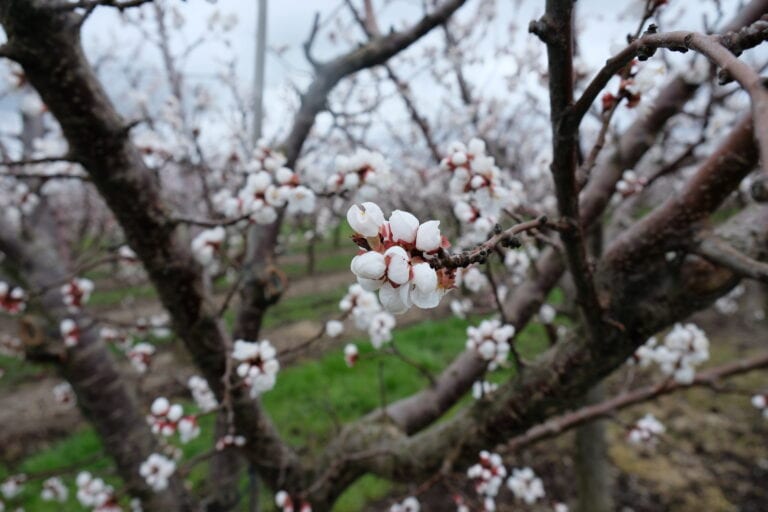Lauren O’Malley
Staff
The hardest-working comedian in NOTL is busy harvesting more than laughter these days. Joe Pillitteri — who in “real life” owns Lakeview Vineyard Equipment — has been busy harvesting grapes too.
Pillitteri was on high alert recently when September’s vicious cycle of heat and rain finally let up and left vineyards full of ripe-to-bursting grapes.
“This weather causes the acceleration of the breakdown of the ripe grapes. That means rot,” explains Pillitteri.
Rot is the enemy of grape growers and winemakers, and avoiding it at GW Wiens Farms means a rush to harvest.
“Emergency picking creates pressure on every level of the process,” Pillitteri continues. “Someone is taking a pay cut just because of the weather.”
Gary Wiens, the farm owner, nods knowingly.
Wineries have specific criteria in terms of sugar levels and volatile acidity — the former determined by the ripeness of the fruit, the latter by the level of rot. Trimming the affected grapes helps to mediate the effect, but a prompt pick has been deemed necessary in the Wiens vineyards.
The atmosphere is all-systems-go, pedal-to-the-metal, with state-of-the-art equipment that gleams with newness and promise.
The name Gregoire GL8 (a heavy-duty grape picker) is said with awe and reverence by the men here. Four harvesters share the work over 20 acres, and the whole year’s growth is picked in a matter of hours.
The Gregoire’s website features a video with booming rock music and close-up dynamic shots of the behemoth’s high technology. In the field, it is loud and windswept, and busy with moving parts. GPS integrates with yield-monitoring technology; catcher trays adapt to the base of each individual vine; auto-steering keeps it on track. The berries are picked by rods and fall onto conveyor belts while suction fans blow out debris like sticks, leaves and rotten berries. Distemper heads act like hands, removing berries from the stems, and the berries are taken through to tanks, having been cleaned three ways.
This is technological efficiency at its best. The roomy and comfortable cab is air-conditioned and has an excellent sound system. Digital screens indicate productivity. Buttons and levers are in use. Some of these harvesters even feature an espresso machine.
Welcome to the future.
According to Pillitteri, at “least 90 per cent” of the vineyards in Niagara-on-the-Lake use Gregoire harvesters in their vineyards.
“There is a world-wide labour shortage — no one wants to do this gruelling work by hand for any amount of money,” he said.
Dean Stoyka, the assistant winemaker at Stratus Vineyards, doesn’t disagree — but nor does Stratus use the dramatic French technology.
“It’s hard to make any argument against what Joe is offering with the Gregoire,” says Stoyka, who also teaches viticulture at Niagara College. But the machinery simply does not fit with Stratus’ mandate to create high-end wine using traditional methods. As far as Stratus is concerned, “Premium winemaking is expensive,” he says, “and involves doing everything by hand.”
The winery uses their eight workers to harvest the grapes when the time is just right. Stratus’ Syrah grapes are at least a week behind those at GW Wiens. Stoyka attributes this to the old-school methods of vineyard maintenance — in which patience is a large part of every step.
“Each cluster in this vineyard is touched individually by hand,” he says with pride.
“Technology can keep improving, but humans will always be better.”
He explains that the individual attention of a person dedicated to looking for everything that is right or wrong with a cluster of grapes will make all the difference. “A machine can’t spot every ladybug, a single rotten grape that’s attracting fruit flies, or one vine that’s producing more or less than others.”
“If we didn’t have these guys doing the great work they’re doing, we would be emergency picking,” says Stoyka. He agrees, though, that in the case of an urgent need to get berries off vines to prevent rot, machines are better.
The contrast between the two properties is vast.
The dynamic energy and noise and human bustle at GW Farms is all 21st century excitement. At Stratus the silence is broken only by birdsong. It’s not idle or leisurely — Stoyka always answers his smartphone on the first ring and has his time mapped out down to the minute. He uses very modern and sophisticated terminology to describe the chemical processes of grape collection and winemaking. He also works for a winery that sells very little wine under $40 a bottle.
These are the ends of the grape harvesting spectrum. Somewhere near the centre of that gamut sits Southbrook Vineyards. Explains winemaker Ann Sperling, “There’s an argument for both sides.” She says, “In our case, organic grapes don’t rot the same as conventional ones. When we went from dry to wet the conventional grapes became much more vulnerable to rot, whereas with organic fruit when the rains came the berries already had a lot more integrity to the skin so they weren’t as vulnerable to rot.” This year there hasn’t yet been a need to bring in the mighty machines. However, “Last year when we had the frost in early November we did use harvesters, recovering better quality fruit by getting it into the winery.”
The fruit brought in for Southbrook’s wines from other farms is also largely harvested by machine. “Technology has improved a lot,” says Sperling. “With the new equipment, MOG (material other than grapes) is staying in the vineyard as the grapes are being harvested — nutrients are going right back into the soil. We have to do that ourselves otherwise.”
It’s all farming, which, like any unpredictable or creative venture, has virtually no limits on its parameters. That’s one of the many things that make living and learning in Niagara so worthwhile.










